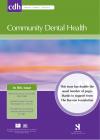Community Dental Health

- Cover Date:
- March 2011
- Print ISSN:
- 0265 539X
- Vol:
- 28
- Issue:
- 1
Using laser fluorescence (DIAGNOdent) in surveys for the detection of noncavitated occlusal dentine caries
Objective The aim of this study was to evaluate the use of the DIAGNOdent system in epidemiological studies to detect noncavitated occlusal caries lesions, and compare the results with those found in radiographic examinations. Methods The sample consisted of 1,290 occlusal surfaces of permanent molars, examined in 179 schoolchildren aged 12-15 years. The methods used were: visual inspection, radiographic examination and DIAGNOdent exam, with radiographic examination being considered the gold standard, and noncavitated caries lesions identified in dentin under sound enamel. The inclusion criterion of this study was to have sound occlusal surfaces on visual inspection. The sensitivity and specificity, positive and negative predictive values were used for statistical analysis. Results: Of the 1,290 surfaces examined during visual inspection, 918 were scored as clinically sound. Of these, 789 were examined by radiographic examination and DIAGNOdent, considering that in more than half of them (410) there were coincident results in the absence of noncavitated lesion in both methods (radiographic examination by DIAGNOdent), with specificity of 74% and negative predictive values of 82% and 155 coincident surfaces with presence of caries, with sensitivity of 64% and positive predictor values of 53% for DIAGNOdent. Conclusion These results suggest that although DIAGNOdent is not a substitute method for the radiographic examination in surveys, it may be an alternative as an auxiliary to visual inspection.
Key words: DIAGNOdent, epidemiology, noncavitated occlusal caries, radiographic examination.
- Article Price
- £15.00
- Institution Article Price
- £0.00
- Page Start
- 17
- Page End
- 21
- Authors
- M. da Luz Rosário de Sousa, M. P. M. Rando-Meirelles
Articles from this issue
- Title
- Pg. Start
- Pg. End
- The caries experience of 5 year-old children in Scotland, Wales and England in 2007-2008 and the impact of consent arrangements. Reports of co-ordinated surveys using BASCD criteria
- 5
- 11
- The dilemma of selecting suitable proximal carious lesions in primary molars for restoration using ART technique.
- 12
- 16
- Using laser fluorescence (DIAGNOdent) in surveys for the detection of noncavitated occlusal dentine caries
- 17
- 21
- The prevalence of and risk factors for non-carious cervical lesions in adults in Hubei Province, China
- 22
- 28
- Health-related lifestyle behaviours, socio-demographic characteristics and use of dental health services in Greek adults.
- 47
- 52
- Periodontal health and treatment needs among hospitalized chronic psychiatric patients in Istanbul, Turkey
- 69
- 74
- Comparison of the COHIP and OHIP- 14 as measures of the oral health-related quality of life of adolescents
- 82
- 88
- Assessment and comparison of periodontal status among young smokers and nonsmokers of Bangalore, India - a cross sectional study.
- 89
- 94
- Smoking and drinking habits and attitudes to smoking cessation counselling among Tanzanian dental students
- 95
- 98
- Traumatic dental injuries to primary incisors and the terminal or occlusal plane relationship in Indian preschool children
- 104
- 106
- Teaching dental public health to undergraduates using community profiles and patient case studies
- 116
- 120
